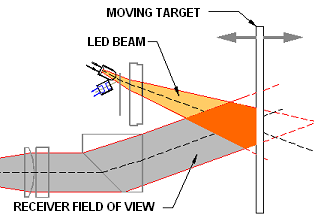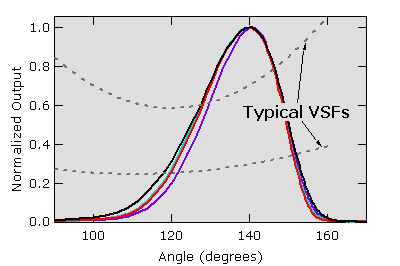Calibration for all HydroScats, a-ßeta, c-ßeta, and Hydroßeta

HOBI Labs' calibration techniques are analyzed in complete detail in a paper published in Applied Optics in 1997. For more information about calibration techniques and measurement of the backscattering coefficient, also see Determining bb with Fixed-Angle Sensors.
The figure at right shows, schematically, the calibration geometry (including a portion of the sensor optics). The target is a diffusely reflecting plate whose distance from the sensor face can be precisely adjusted throughout its sensitive range.
The major benefits of this method are:
- Mathematically rigorous
- Accuracy depends only on a stable, predictable reflectance standard
- Uses relatively simple equipment
- Does not consume expensive standard particles
- Does not require special solutions
- Does not involve other instruments
- Can be performed in the field and in user labs.

HydroScat-4 response vs distance
Calibration curves from a HydroScat-4 are shown at left. Results for the four wavelengths have been normalized to the same peak value to show the typical variations in shape from channel to channel. Although small, these differences are significant. Because we measure them directly and account for them, they do not cause any error in the results.

HydroScat-4 response vs scattering angle
In the plot of results versus angle, we show the typical range of VSF measurements over the same range of angles. This illustrates that while we speak of measuring the scattering at a particular angle, it is important to remember that all practical sensors measure over significant range of angles. For more on this topic, see Determining bb with Fixed-Angle Sensors.